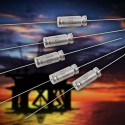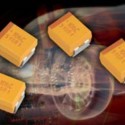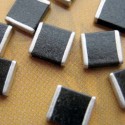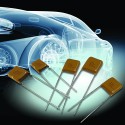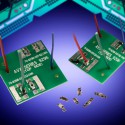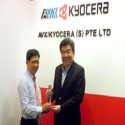FOUNTAIN INN, S.C. (June 30, 2015) – AVX Corporation, a leading manufacturer of passive components and interconnect solutions, has introduced a new series of wet tantalum capacitors designed for use at 200°C, many of which are capable of up to 2,000 hours of operation with applicable derating. Featuring a high capacitance cathode system that enables high CV performance in standard DSCC case sizes spanning T1 – T4, the new TWA-Y Series delivers high reliability, high temperature, and long lifetime performance, and exhibits stable electrical parameters over temperature (-55°C to +200°C). Hermetically sealed in a welded tantalum can and header assembly, TWA-Y Series capacitors satisfy the harsh mechanical shock and high frequency vibration requirements for both MIL-PRF-39006 and MIL-STD-202, making them
News / Events / Press
FOUNTAIN INN, S.C. (June 25, 2015) – AVX Corporation, a leading manufacturer of passive components and interconnect solutions, has received a silver-level 2014 Perfect Order Index (POI) Award in the Passive Electromechanical Components Supplier category from Arrow Electronics, a global provider of products, services, and solutions to industrial and commercial users of electronic components and enterprise computing solutions. Launched in 2012, the Perfect Order Index Awards recognize Arrow suppliers that achieve best-in-class performance by delivering perfect orders, as measured by the same eight metrics to which Arrow holds itself accountable with regard to on-time delivery and end-to-end customer quality, including: the right product, the right quality, and delivery at the right place and the right time. “Arrow congratulates all of
FOUNTAIN INN, S.C. (June 24, 2015) – AVX Corporation, a leading manufacturer of passive components and interconnect solutions, has added more than a dozen new high-reliability SMD tantalum capacitors to its TMJ S1gma™ Series, which exhibits the lowest DCL and twice the reliability of any commercial grade tantalum capacitors currently on the market (0.005CV standard and 0.001CV on selected codes), in addition to an impressively scant baseline part failure rate of < 0.5% per 1,000 hours at 85°C and rated voltage. Available with three levels of next-generation statistical screening and process control enhancement for applications in which exceedingly high reliability, extremely low DC leakage current (DCL), and extended battery life are paramount, the new TMJ S1gma Series capacitors are ideal
FOUNTAIN INN, S.C. (June 22, 2015) — AVX Corporation, a leading manufacturer of passive components and interconnect solutions, has announced that, after several years of extensive testing, its space-level X7R base metal electrode (BME) MLCCs have achieved the European Space Association’s (ESA’s) Qualified Parts List (QPL) status under the criteria of the European Space Components Coordination’s (ESCC’s) 3009/041 specification, making them the first X7R BME MLCCs fully qualified for use in European and American space applications. Exhibiting capacitance voltage (CV) capabilities superior to those of traditional precious metal electrode (PME) MLCCs, AVXs space-level BME MLCCs provide the extremely high reliability performance required by the space industry while delivering higher capacitance values in significantly smaller cases sizes, enabling revolutionary reductions of
FOUNTAIN INN, S.C. (June 16, 2015) — AVX Corporation, a leading manufacturer of passive components and interconnect solutions, has been globally honored with prestigious 2014 TTI Supplier Excellence Awards for having earned the award in each of the company’s three regions: Europe, Asia, and the Americas. Bestowed by TTI, Inc., the leading authorized distributor of interconnect, passive, electromechanical, and discrete components, the TTI Supplier Excellence Awards recognize AVX for its successful fulfillment of several key quality performance metrics intended to elevate supplier and distributor performance in order to ensure utmost customer satisfaction worldwide. Representing the highest possible recognition of a supplier’s performance with regard to quality acceptance, ship-to-commit delivery date, effective business systems, ease of doing business, and both the
FOUNTAIN INN, S.C. (June 15, 2015) — AVX Corporation, a leading manufacturer of passive components and interconnect solutions, has introduced a new web-based simulation tool for its tantalum, polymer, and niobium oxide capacitors. Featuring data mined from the libraries of AVX’s previous PSpice Models and S-Parameters S2P software, which, now redundant, have been removed from the website, the new, interactive SpiTAN IV software provides design engineers with a user-friendly program for reviewing critical electrical and performance characteristics for individual part numbers by temperature and frequency, allowing them to identify and accurately select the optimum capacitors for their applications. Searchable by part number or product type — the list of which currently includes: low profile, high CV, low ESR, polymer, niobium
FOUNTAIN INN, S.C. (May 14, 2015) — AVX Corporation, a leading manufacturer of advanced passive components and interconnect solutions, has added a new 1206 chip size and extensive new voltage, clamping voltage, and energy ratings to its Glass Encapsulated TransGuard® and TransGuard Automotive Series multilayer varistors. Comprised of zinc oxide (ZnO) based ceramic semiconductor devices with non-linear, bi-directional voltage-current (V–I) characteristics similar to those of back-to-back Zener diodes, both multilayer varistor series provide bi-directional overvoltage protection and EMI/RFI attenuation in a single SMT package, exhibit high current and energy handling capabilities, and are glass encapsulated to provide enhanced resistance against harsh environments and processes, including acids, salt, and chlorine flux. Both series also exhibit sub 1nS response times to ESD
FOUNTAIN INN, S.C. (May 13, 2015) – AVX Corporation, a leading manufacturer of passive components and interconnect solutions, has added a single contact, wire-to-board (WTB) insulation displacement connector (IDC) with plated through hole (PTH) terminations to its proven 9176 Series, which, prior to the addition, was exclusively comprised of surface mount technology (SMT) connectors. Delivering the same features and benefits for which the 9176 Series is known — including a gas-tight connection to the PCB for long-term reliability, preassembled strain relief caps with through-wire or end-stop configurations for maximum flexibility, reduced cost compared to hand soldering and two-piece connector options, and the tested ability to withstand automotive levels of shock, vibration, and temperature cycling — the new single tine 9176-60X
FOUNTAIN INN, S.C. (May 12, 2015) – AVX Corporation, a leading manufacturer of passive components and interconnect solutions, has introduced the new SV Series high voltage, automotive grade, multilayer ceramic (MLC), radial-leaded capacitors. Qualified to AEC-Q200 and rated for 1,000VDC, the new SV Series capacitors are designed with C0G (NP0) Class I dielectric materials, which exhibit an extremely low dissipation factor — providing excellent high rms current handling capabilities with minimal power losses in medium to high power resonant converters — and radial leads, which enable the mechanical decoupling of the MLC chip from the board, and provide the maximum mechanical stress relief necessary for harsh automotive applications. Conformally coated to eliminate the potential for arc flashover, SV Series capacitors
FOUNTAIN INN, S.C. (May 12, 2015) – AVX Corporation, a leading manufacturer of passive components and interconnect solutions, has released a new 2mm vertical poke-home wire-to-board (WTB) contact. The latest addition to AVX’s 70-9296 Series, the new micro contact accepts 26–22AWG solid or stranded wires, supports current ratings as high as 8A, and is 37% smaller than the next smallest offering in the series (a 3mm vertical poke home WTB contact), which makes it compatible with smaller wire gauges and devices, and extends the applications for the series to light industrial electronics, such as display case and under cabinet SSL products with lower current and shorter runs, switches, lighting strips, and motion, pressure, and temperature sensors, amongst several others. The
FOUNTAIN INN, S.C. (April 28, 2015) – AVX Corporation, a leading manufacturer of passive components and interconnect solutions, is attending the 2015 Electronic Distribution Show (EDS), which will take place May 12 – 15 at The Mirage Hotel and Casino in Las Vegas. At the event, AVX will introduce four new products, meet with its various sales and distribution partners, and attend the 2015 ECN Impact Awards as a finalist in the Passive Components and Discrete Semiconductors category. The premier annual event for the international electronic distribution industry, EDS hosts approximately 5,000 individuals representing more than 80% of the industry each year. Participants include electronic distributors, suppliers who provide distributors with an array of value-added equipment and services in addition
FOUNTAIN INN, S.C. (April 24, 2015) – AVX Corporation, a leading manufacturer of passive components and interconnect solutions, has received a prestigious 2014 TTI Asia Supplier Excellence Award. Bestowed by TTI, Inc., the leading authorized distributor of interconnect, passive, electromechanical, and discrete components, the award honors AVX for its successful fulfillment of several key quality performance metrics designed to elevate supplier and distributor performance in order to ensure utmost customer satisfaction. The 2014 TTI Asia Supplier Excellence Award represents the highest recognition possible of a supplier’s performance within TTI Asia with regard to quality acceptance, ship-to-commit delivery date, effective business systems, ease of doing business, and the quality and efficacy of field employee and management relationships. Mr. Anthony Chan, President,
FOUNTAIN INN, S.C. (MARCH 17, 2015) – AVX Corporation, a leading manufacturer of passive components and interconnect solutions, has introduced a single contact version of its proven 9176 Series insulation displacement connectors (IDCs), which are widely recognized for providing highly reliable, gas-tight wire-to-board connections in a range of harsh environment applications. Backward compatible with existing 9176 Series connectors with regard to contact and footprint, the new 9176-65X single tine IDC contacts exhibit the same robust, reliable performance the series is known for while reducing cost by 25%, width by 50% (2.5mm vs. 5.0mm), and height by 10% (5.05mm vs. 5.6mm), the latter of which is especially valuable for SSL applications, as it helps prevent shadowing. Designed to satisfy the demanding
Polymer Tantalum Capacitors with Suppressed Transient Current Written By: Jan Petržílek | Miloslav Uher | Jiří Navrátil Abstract: Tantalum electrolytic capacitors are renowned for their high capacitance and volumetric efficiency, parametric stability over a long service lifetime, and long-term reliability under harsh operating conditions. The anode is constructed of a porous pellet of sintered tantalum powder with a dielectric of tantalum pentoxide formed by electrochemical anodization. The traditional cathode materials have been either a liquid electrolyte (wet hermetic types) or manganese dioxide (solid MnO2 surface mount types). However, the most recent material, fast becoming a popular option, is conductive polymer. The Polymer Tantalum capacitor was originally marketed toward consumer electronic applications, however after years of effort and continuous improvement, significant
Voltage Derating Rules for Solid Tantalum and Niobium Capacitors Written By: Tomáš Zedníček | John Gill Abstract: For many years, whenever people have asked tantalum capacitor manufacturers for general recommendations on using their product, the consensus was “a minimum of 50% voltage derating should be applied”. This rule of thumb has since become the most prevalent design guideline for tantalum technology. This paper revisits this statement and explains, given an understanding of the application, why this is not necessarily the case. With the recent introduction of niobium and niobium oxide capacitor technologies, the derating discussion has been extended to these capacitor families also.
Ultrathin Discrete Capacitors for Emerging Embedded Technology Written By: Radim Uher | Tomas Zednicek Abstract: Passive components can represent as much as 70% of PCB footprint in today’s electronic systems. The development of a suitable technology whereby integrated passive components are embedded into the PCB body has been one of the key trends in downsizing for more than a decade. Latest achievements have allowed the implementation of this ‘embedding technology’ into pre-production and even mass production. The next step requires the involvement of the complete supply chain, including traditional passive component manufacturers. This paper will present the state of the art in the development of ultrathin discrete capacitor technology and discuss the challenges of overcoming mechanical, electrical and thermo-mechanical issues
